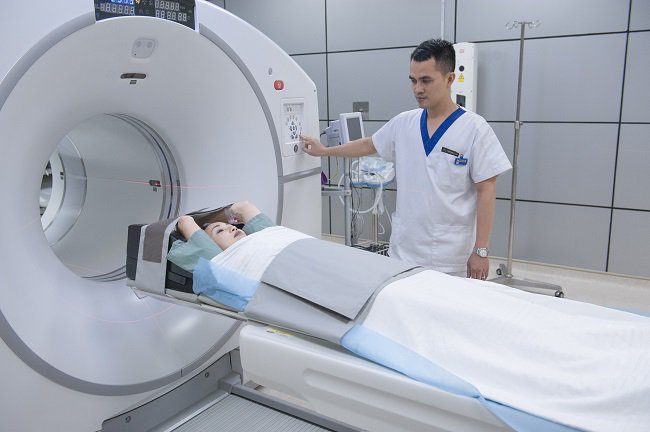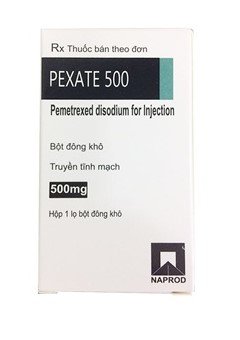Modern science enables accurate lung cancer screening
The article was professionally consulted by Specialist Doctor I Le Thien Quang - Internal Oncologist - Department of Medical Examination & Internal Medicine - Vinmec Da Nang International Hospital
Lung cancer is a dangerous disease, currently with the second highest incidence and mortality rate of all cancers. With the advancement of medicine, lung cancer can be accurately screened with modern imaging equipment. So how is lung cancer screened, let's find out!
1. What is lung cancer?
Cancer is a condition in which cells grow, multiply uncontrollably, invade surrounding areas and metastasize. Lung cancer is of two types, small cell lung cancer and non-small cell lung cancer.
According to the latest statistics in 2018, each year there are nearly 24,000 new cases of lung cancer and over 20,000 deaths, enough to see the danger of this disease.

Ung thư phổi cần sàng lọc sớm
2. Why screen for lung cancer?
Any cancer should be screened for early detection, treatment at the early stages to achieve the best results, reduce treatment costs, limit complications, and improve quality of life. With a disease with a high incidence and mortality rate like lung cancer is no exception. If detected late, lung cancer treatment results are extremely limited, the cost is very high, the quality of life is reduced and the patient's remaining time is not much.
3. Accurate lung cancer screening with modern imaging equipment
Classical lung cancer screening can be done by methods such as chest X-ray, sputum histopathology, but these two methods, whether used alone or at the same time, are very ineffective and does not reduce the risk of dying from lung cancer.
With the development of medicine, more advanced and modern methods were born and today's highest technology, which has proven to be effective, is low-dose computed tomography (LDCT). ) thoracic cavity.
Low dose computed tomography is a special technique, combining modern equipment, complex computer algorithms, creating many thin slices to early detect even the smallest lesions, while reducing the amount of radiation the patient is subjected to compared to conventional computed tomography, improving patient safety.
4. Who should be screened for lung cancer?
According to the latest recommendations of the American Cancer Society, lung cancer screening should be conducted annually, using low-dose computed tomography, for the following subjects:
Age 55 - 74 years , in good health Current smoker, or has quit for less than 15 years Smokes 30-pack-years* or more Accepts to quit if still smokes Counseled , clearly explaining the benefits, limitations, and risks of lung cancer screening. Lung cancer screening can be carried out at a center with advanced and modern human resources, equipment, and facilities * Number of packages -year of cigarettes is calculated according to the formula:
(Number of packs-years) = (Number of packs/day) x (Number of years smoked)
1 includes 20 cigarettes
Age 55 - 74 years , in good health Current smoker, or has quit for less than 15 years Smokes 30-pack-years* or more Accepts to quit if still smokes Counseled , clearly explaining the benefits, limitations, and risks of lung cancer screening. Lung cancer screening can be carried out at a center with advanced and modern human resources, equipment, and facilities * Number of packages -year of cigarettes is calculated according to the formula:
(Number of packs-years) = (Number of packs/day) x (Number of years smoked)
1 includes 20 cigarettes
5. What are the benefits and risks of lung cancer screening?
Benefits:
Conventional computed tomography has the ability to detect very small abnormalities in the lungs, with low-dose computed tomography, the effect is much greater, easily detecting the disease in the earliest stage, the easiest to treat, and the most effective. The imaging process is relatively fast, easy to perform even for patients who have difficulty when asked to hold their breath (patients will be asked to hold their breath for a very short time, about 5-10 seconds during the scan). . The procedure is painless, non-invasive, and low-dose computed tomography does not require the use of contrast agents. There is no residual radiation after the scan. Radiation used in low-dose computed tomography does not cause immediate side effects, does not affect metal objects in the patient (such as pacemakers, artificial joints,...). Low-dose computed tomography uses a much lower dose of radiation than standard computed tomography. Lung cancer screening with low-dose computed tomography has been shown to reduce mortality in high-risk populations. When cancer is detected, it is often detected at a very early stage, making treatment more effective and easier. Risk:
False positives can occur when the end result is abnormal, but cancer is not present. At this point, additional tests may be needed, possibly repeating the computed tomography scan or performing an invasive test, such as a lung biopsy. In this case, the patient will be carefully consulted. False negative, i.e. the end result is completely normal, but the patient actually has cancer. Not all cancers detected by low-dose computed tomography are at an early stage. If the disease is already at a late stage, the treatment results will be very limited, the survival time is short and the quality of life is reduced. Therefore, early cancer screening is very important.
Conventional computed tomography has the ability to detect very small abnormalities in the lungs, with low-dose computed tomography, the effect is much greater, easily detecting the disease in the earliest stage, the easiest to treat, and the most effective. The imaging process is relatively fast, easy to perform even for patients who have difficulty when asked to hold their breath (patients will be asked to hold their breath for a very short time, about 5-10 seconds during the scan). . The procedure is painless, non-invasive, and low-dose computed tomography does not require the use of contrast agents. There is no residual radiation after the scan. Radiation used in low-dose computed tomography does not cause immediate side effects, does not affect metal objects in the patient (such as pacemakers, artificial joints,...). Low-dose computed tomography uses a much lower dose of radiation than standard computed tomography. Lung cancer screening with low-dose computed tomography has been shown to reduce mortality in high-risk populations. When cancer is detected, it is often detected at a very early stage, making treatment more effective and easier. Risk:
False positives can occur when the end result is abnormal, but cancer is not present. At this point, additional tests may be needed, possibly repeating the computed tomography scan or performing an invasive test, such as a lung biopsy. In this case, the patient will be carefully consulted. False negative, i.e. the end result is completely normal, but the patient actually has cancer. Not all cancers detected by low-dose computed tomography are at an early stage. If the disease is already at a late stage, the treatment results will be very limited, the survival time is short and the quality of life is reduced. Therefore, early cancer screening is very important.

Sàng lọc ung thư phổi với máy chụp CT 128 lát
Understanding the importance as well as the need for early screening for lung cancer, Vinmec International Hospital is currently implementing a Lung Cancer Screening Package, patients will be examined and consulted by a team of leading experts. Experienced, comprehensive cooperation with domestic and international hospitals, with modern facilities, leading high-tech equipment in Vietnam (especially 128-slice CT scanner), meeting fully respond to the motto of individualizing each patient, towards the goal of all for the health and quality of life of the patient.
Để đặt lịch khám tại viện, Quý khách vui lòng bấm số HOTLINE hoặc đặt lịch trực tiếp TẠI ĐÂY. Tải và đặt lịch khám tự động trên ứng dụng MyVinmec để quản lý, theo dõi lịch và đặt hẹn mọi lúc mọi nơi ngay trên ứng dụng.






